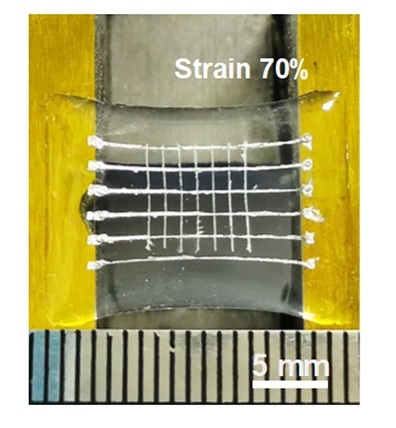
A research group led by Prof. LI Runwei at the Ningbo Institute of Materials Technology and Engineering (NIMTE) of the Chinese Academy of Sciences (CAS) have proposed a "slight crosslinking" method that imparts elastic recovery to ferroelectric materials.
The study was published in Science.
Ferroelectric materials are very useful for applications such as data storage and processing, sensing, energy conversion, and optoelectronics, etc., making them highly desirable in mobile phones, tablets and other electronic devices for everyday use.
After stress is relieved, however, conventional ferroelectric materials exhibit poor elastic recovery—typically less than 2%, thus tend to be either brittle (ferroelectric ceramics) or plastic (ferroelectric polymers).
The ferroelectric properties of these materials are mainly due to their crystalline regions, which lack intrinsic elasticity.
To solve the dilemma of ferroelectric response and elastic recovery, the researchers developed a precise "slight crosslinking" method.
By using poly(vinylidene fluoride–trifluoroethylene) as the matrix material and soft-long-chain polyethylene oxide diamine as the crosslinker, the researchers established a network structure in linear ferroelectric polymers.
By precisely controlling the crosslinking density at 1–2%, the crosslinked ferroelectric film mainly exhibited a β-phase crystalline structure and was uniformly dispersed in the crosslinked polymer network.
Under stress, the network structure can evenly distribute and bear external forces, thereby mitigating damage to the crystalline regions. Thus, these newly developed ferroelectrics combine elasticity with relatively high crystallinity. Experimental results also showed that the cross-linked film retained a stable ferroelectric response and elastic recovery even under strains up to 70%.
"Based on their study," said Prof. XIONG Rengen, an internationally renowned expert in ferroelectric materials, "GAO Liang et al. have established a new research direction, elastic ferroelectrics."
Elastic ferroelectrics such as these, with excellent resistance to mechanical and ferroelectric fatigue, have broad application prospects in wearable electronics and smart healthcare.
This work was supported by the National Natural Science Foundation of China, the Zhejiang Province Qianjiang Talent Program, and the K.C. Wong Education Foundation, among others.

The elastic ferroelectrics under 70% strain. (Image by NIMTE)

86-10-68597521 (day)
86-10-68597289 (night)

86-10-68511095 (day)
86-10-68512458 (night)

cas_en@cas.cn

52 Sanlihe Rd., Xicheng District,
Beijing, China (100864)

